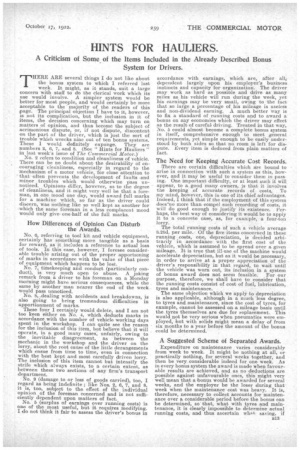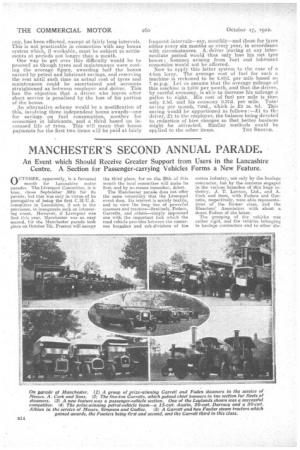HINTS FOR HAULIERS.
Page 13

Page 14

If you've noticed an error in this article please click here to report it so we can fix it.
A Criticism of Some of the Items Included in the Already Described Bonus System for Drivers.
THERE ARE several things I do not like about the bonus system to which I referred last week. It might, as it stands, suit a large concern with staff to do the clerical work which its use would involve. A simpler system would be better for most people, and would certainly be more acceptable to the majority of the readers of this page. The principal objection I have to it, however, is not its complication, but the inclusion in it of items, the decision concerning which may turn on matters of opinion, and thus become the subject of acrimonious dispute, or, if not dispute, discontent on the part of the driver, which is just the sort of trouble which wrecks nine out of ten bonus systems. These I would definitely expunge. They are numbers 2, 6, 7, and 8. (See " Hints for Hauliers" in last week's issue of The Commercial Motor.). 3'.+To. 2 refers to condition and cleanliness of vehicle. There can be no doubt about the desirability of encouraging cleanliness, especially in regard to the mechanism of a motor vehicle, for close attention to that often prevents the development of faults and minor troubles which would otherwise pass unnoticed. Opinions differ, however, as to the degree of cleanliness, and it might very well be that a foreman, in one mood one day, would award full marks for a machine which, so far as the driver could discern, was nothing like so well kept as another for which the same foreman in a less complacent mood would only giveone-half of the full marks.
How Differences of Opinion Can Disturb the Awards.
No. 6, referring to tool kit and vehicle equipment, certainly has something more tangible as a basis for reward, as it includes a reference to actual loss of tools. In this case, however, I foresee considerable trouble arising out of the proper apportioning of marks in accordance with the value of that piece of equipment which happens to be lost.
No. 7, timekeeping and conduct (particularly conduct), is very much open to abuse. A joking remark from a driver to his foreman on a Monday morning might have serious consequences, while the same by another man nearer the end of the weekwould pass unnoticed.
No. 8, dealing with accidents and breakdowns, is also going to bring tremendous difficulties in apportionment of marks.
These four I certainly would delete, and I am not too keen either on No. 4, which deducts marks in accordance with the number of vehicle working days spent in the workshop. I can quite see the reason for the inclusion of this item, but believe that it will operate, in a good many cases; unfairly, owing to the inevitable disagreement, as between the mechanic in the workshop and the driver on the lorry, about the root cause of the little derangements which ensue from time to time, even in connection with the best kept and most carefully driven lorry. The inclusion of this item cannot but intensify the strife which always exists, to a certain extent, as between these two sections of any firm's transport department.
No. 9 (damage to or loss of goods carried), too, I regard as being indefinite ; like Nos. 2, 6, 7, and 8, it is, too subject to the effect of the individual opinion Of the foreman concerned and is not sufficiently dependent upon matters of fact. No. 5 (surplus of earnings over running costs) is one of the most useful, but it requires modifying. I do not think it fair to assess the driver's bonus in accordance with earnings, which are, after all, dependent largely upon his employees business instincts and capacity for organization. The driver may work as hard as possible and drive as many miles as. his vehicle will run during the week, yet his earnings may be very small, owing to the fact that .so large a percentage of his mileage is useless and non-dividend earning. A. much better way is to fix a standard of running costs and to award a bonus on any economies which the driver may effect as the result of careful driving. Treated in that way, No. 5 could almost become a complete bonus system in itself, comprehensive enough to meet general requirements, yet simple enough to be easily understood by both sides so that no room is left for dispute. Every item is deduced from plain matters of fact.
The Need for Keeping Accurate Cost Records.
!There are certain difficulties which are bound to arise in connection with such a system as this, however, and it may be useful to consider them in passing. One important difficulty, or at least such it will appear, to a good many owners, is that it involves the keeping of accurate records of costs. To my mind, however, this is one of its chief advantages. Indeed, I think that if the employment of this system does'no more than compel such recording of costs, it will do good enough to justify its existence. Perhaps the best way of considering it would be to apply it fr.: a concrete case, as, for example, a four-ton lorry.
The total running costs of such a vehicle average 8.28d. per mile. Of the five items concerned in these running costs, one, depreciation, is decided arbitrarily in accordance with the first cost of the vehicle, which is assumed to be spread over a given mileage. It is true that ill-use of the machine would accelerate depreciation, but as it would be necessary, inorder to arrive at a proper appreciation of the driver's responsibility in that regard, to wait until the vehicle was worn out, its inclusion in a system of bonus award does not seem feasible. For our purpose, therefore, we shall have to consider that the running costs consist of cost of fuel, lubrication, tyres and maintenance. The same objection which we apply to depreciation is also applicable, although in a much less degree, to tyres and maintenance, since the cost of tyres, for example, cannot be assessed on a mileage basis until the tyres themselves are due for replacement. This would not be very serious when pneumatics were employed, but with solids might mean a delay of from six months to a year before the amount of the bonus could be determined.
A Suggested Scheme of Separated Awards.
Expenditure on maintenance varies considerably from week to week. It might be nothing at all, or practically nothing, for several weeks together, and then be very considerable indeed for one week. As in every bonus system the award is made when favourable results are achieved, and as no deductions are possible against unfavourable ones, this might very well mean that a bonus would be awarded for several weeks, and the employer be the loser during that week when the maintenance cost was heavy. It is, therefore, necessary to collect accounts for maintenance over a considerable period before the bonus can be determined, sothat, what with tyres and maintenance, it is clearly impossible to determine actual running costs, and thus ascertain what saving, if
any, has been effected, except at fairly long intervals. This is not practicable in connection with any bonus system which, if workable, must be subject to settlements at periods not longer than a month.
One way to get over this difficulty would be to proceed as though tyres and maintenance were costing the average figure, awarding half the bonus earned by petrol and lubricant savings, and reserving the rest until such time as actual cost of tyres and maintenance could be ascertained and accounts straightened as between employer and driver. This has the objection that a driver who leaves after short service is penalized by the loss of his portion of the bonus.
An alternative scheme would be a modification of this, involving three independent bonus awards—one for savings on fuel consumption, another for economies in lubricants, and a third based on increased life of tyres. This will mean that bonus payments for the first two items will be paid at fairly
frequent intervals—say, monthly—and those for tyres .either every six months or every year, in accordance with circumstances. A. driver leaving at any intermediate period would thus only lose his net tyre bonus ; bonuses arising from fuel and lubricant economies would not be affected.
Now to apply this latter system to the case of a 4-ton lorry. The average cost of fuel for such a machine is reckoned to be 2.8'7d. per mile based on 7 m.p.g. Let us assume that the average mileage of this machine is 2,000 per month, ,and that the driver, by careful economy, is able to increase his mileage a gallon to eight. His cost of fuel per mile is then only 2.5d. and his economy 0.37d. per mile. Total saving per month, 740d., which is E3 is. 84.1. This saving would be apportioned as follows to th,! driver, la to the employer, the balance being devoted to reduction of hire charges 130, that better business might be attracted. Similar methods could be applied to the other items. THE SKOTCH.
































